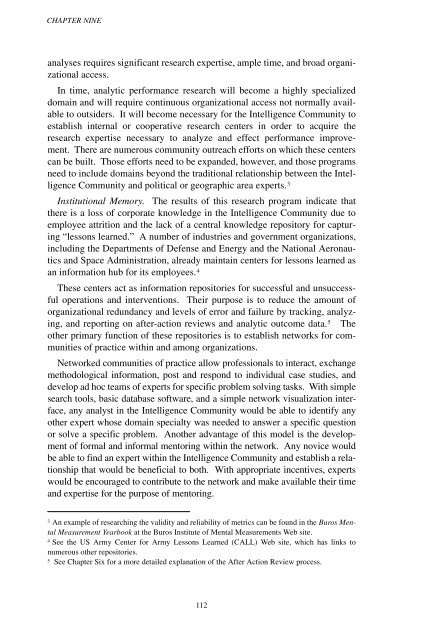Analytic Culture in the U.S. Intelligence Community (PDF) - CIA
Analytic Culture in the U.S. Intelligence Community (PDF) - CIA
Analytic Culture in the U.S. Intelligence Community (PDF) - CIA
You also want an ePaper? Increase the reach of your titles
YUMPU automatically turns print PDFs into web optimized ePapers that Google loves.
CHAPTER NINE<br />
analyses requires significant research expertise, ample time, and broad organizational<br />
access.<br />
In time, analytic performance research will become a highly specialized<br />
doma<strong>in</strong> and will require cont<strong>in</strong>uous organizational access not normally available<br />
to outsiders. It will become necessary for <strong>the</strong> <strong>Intelligence</strong> <strong>Community</strong> to<br />
establish <strong>in</strong>ternal or cooperative research centers <strong>in</strong> order to acquire <strong>the</strong><br />
research expertise necessary to analyze and effect performance improvement.<br />
There are numerous community outreach efforts on which <strong>the</strong>se centers<br />
can be built. Those efforts need to be expanded, however, and those programs<br />
need to <strong>in</strong>clude doma<strong>in</strong>s beyond <strong>the</strong> traditional relationship between <strong>the</strong> <strong>Intelligence</strong><br />
<strong>Community</strong> and political or geographic area experts. 3<br />
Institutional Memory. The results of this research program <strong>in</strong>dicate that<br />
<strong>the</strong>re is a loss of corporate knowledge <strong>in</strong> <strong>the</strong> <strong>Intelligence</strong> <strong>Community</strong> due to<br />
employee attrition and <strong>the</strong> lack of a central knowledge repository for captur<strong>in</strong>g<br />
“lessons learned.” A number of <strong>in</strong>dustries and government organizations,<br />
<strong>in</strong>clud<strong>in</strong>g <strong>the</strong> Departments of Defense and Energy and <strong>the</strong> National Aeronautics<br />
and Space Adm<strong>in</strong>istration, already ma<strong>in</strong>ta<strong>in</strong> centers for lessons learned as<br />
an <strong>in</strong>formation hub for its employees. 4<br />
These centers act as <strong>in</strong>formation repositories for successful and unsuccessful<br />
operations and <strong>in</strong>terventions. Their purpose is to reduce <strong>the</strong> amount of<br />
organizational redundancy and levels of error and failure by track<strong>in</strong>g, analyz<strong>in</strong>g,<br />
and report<strong>in</strong>g on after-action reviews and analytic outcome data. 5 The<br />
o<strong>the</strong>r primary function of <strong>the</strong>se repositories is to establish networks for communities<br />
of practice with<strong>in</strong> and among organizations.<br />
Networked communities of practice allow professionals to <strong>in</strong>teract, exchange<br />
methodological <strong>in</strong>formation, post and respond to <strong>in</strong>dividual case studies, and<br />
develop ad hoc teams of experts for specific problem solv<strong>in</strong>g tasks. With simple<br />
search tools, basic database software, and a simple network visualization <strong>in</strong>terface,<br />
any analyst <strong>in</strong> <strong>the</strong> <strong>Intelligence</strong> <strong>Community</strong> would be able to identify any<br />
o<strong>the</strong>r expert whose doma<strong>in</strong> specialty was needed to answer a specific question<br />
or solve a specific problem. Ano<strong>the</strong>r advantage of this model is <strong>the</strong> development<br />
of formal and <strong>in</strong>formal mentor<strong>in</strong>g with<strong>in</strong> <strong>the</strong> network. Any novice would<br />
be able to f<strong>in</strong>d an expert with<strong>in</strong> <strong>the</strong> <strong>Intelligence</strong> <strong>Community</strong> and establish a relationship<br />
that would be beneficial to both. With appropriate <strong>in</strong>centives, experts<br />
would be encouraged to contribute to <strong>the</strong> network and make available <strong>the</strong>ir time<br />
and expertise for <strong>the</strong> purpose of mentor<strong>in</strong>g.<br />
3<br />
An example of research<strong>in</strong>g <strong>the</strong> validity and reliability of metrics can be found <strong>in</strong> <strong>the</strong> Buros Mental<br />
Measurement Yearbook at <strong>the</strong> Buros Institute of Mental Measurements Web site.<br />
4<br />
See <strong>the</strong> US Army Center for Army Lessons Learned (CALL) Web site, which has l<strong>in</strong>ks to<br />
numerous o<strong>the</strong>r repositories.<br />
5<br />
See Chapter Six for a more detailed explanation of <strong>the</strong> After Action Review process.<br />
112
















